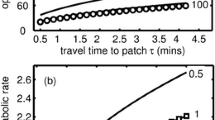Summary
Adult bananaquits on negative energy budgets were presented with a patch containing two flower types with identical mean rewards, but different variances. The flower patch contained a random array of 85 yellow and 85 red artificial flowers. Flowers of one color were filled with the same quantity of nectar (constant flowers); flowers of the other color were filled with variable quantities of nectar (variable flowers). In the first series of experiments the birds were given three presentations, followed by three more presentations with the flower colors reversed, to control for color preferences. Some individuals were occasionally indifferent during a presentation, but overall the birds significantly preferred the constant flowers. In the second series of experiments two birds were give five presentations of the floral patch during a day at a rate less than minimally required to meet all 24-h energy costs. In all experiments, bananaquits on negative energy budgets were either indifferent or risk-averse, but never risk-prone. The absence of risk-prone foraging might be attributed to resource dispersion pattern, reward skew, or a species characteristic.
Similar content being viewed by others
References
Barnard CJ, Brown CAJ (1985) Risk-sensitivity in foraging common shrews (Sorex araneus L.). Behav Ecol Sociobiol 16:161–164
Battalio RC, Kagel JH, MacDonald DN (1985) Animals' choices over uncertain outcomes: some initial experimental results. Am Econ Review 75:597–613
Caraco T (1980) On foraging time allocation in a stochastic environment. Ecology 61:119–128
Caraco T (1981) Energy budgets, risk and foraging preferences in Dark-eyed Juncos (Junco hyemalis). Behav Ecol Sociobiol 8:213–217
Caraco T (1982) Aspects of risk aversion in foraging Whitecrowned Sparrows. Anim Behav 30:719–727
Caraco T (1983) White-crowned sparrows (Zonotrichia leucophrys): foraging preferences in a risky environment. Behav Ecol Sociobiol 12:63–69
Caraco T, Chasin M (1984) Foraging preferences: responses to reward skew. Animal Behav 32:76–85
Caraco T, Martindale S, Whittam TS (1980) An empirical demonstration of risk-sensitive foraging preferences. Animal Behav 28:820–830
Faaborg J, Arendt WJ, Kaiser MS (1984) Rainfall correlates of bird population fluctuations in a Puerto Rican dry forest: a nine year study. wilson Bull 96:575–593
Feinsinger P (1978) Ecological interactions between plants and hummingbirds in a successional tropical community. Ecol Mon 48:269–287
Feinsinger P, Swarm LA, Wolfe JA (1985) Nectar-feeding birds on Trinidad and Tobago: comparison of diverse and depauperate guilds. Ecol Mon 55:1–28
Gass CL (1978) Experimental studies of foraging in complex laboratory environments. Am Zoologist 18:617–626
Hainsworth FR (1974) Food quality and foraging efficiency. J Comp Physiol 88:425–431
Hainsworth FR (1978) Feeding: a model of costs and benefits in energy regulation. Am Zoologist 18:701–714
hainsworth FR Wolf LL (1978) Feeding: An ecological approach. Adv in the Study of Behav 9:53–96
Heiner RA (1983) The origin of predictable behavior. Amer Econ Rev 73:560–595
Houston AI, McNamara JM (1982) A sequential approach to risk-taking. Anim Behav 30:1260–1261
Houston AI, McNamara JM (1985) The choice of two prey types that minimises the probability of starvation. Behav Ecol Sociobiol 17:135–141
Houston AI, McNamara JM (1986) Evaluating the selection pressure on foraging decisions. In: Campan R, Zavan R (ed) Relevance of models and theories in ethology. Privat, I.E.C, Toulouse, France, pp 61–75
Kendeigh SC (1970) Energy requirements for existence in relation to size of bird. Condor 72:60–65
Lasiewski RC, Dawson WR (1967) A re-examination of the relation between standard metabolic rate and body weight in birds. Condor 69:13–23
Leventhal AM, Morrell RF, Morgan EF Jr, Perkins CC Jr (1959) The relation between mean reward and mean reinforcement. J Exp Psychol 57:284–287
McNamara JM, Houston AI (1986) The common currency for behavioral decisions. Am Nat 127:358–378
Oster G, Wilson EO (1978) Caste and ecology in the social insects. Princeton University Press, Princeton
Real L (1980a) Fitness, uncertainty, and the role of diversification in evolution and behavior. Am Nat 115:623–638
Real L (1980b) On uncertainty and the law of diminishing returns in evolution and behavior. In: Staddon JER (ed) Limits to action. Academic Press, New York
Real L (1981) Uncertainty and pollinator-plant interactions: the foraging behavior of bees and wasps on artificial flowers. Ecology 62:20–26
Real L, Caraco T (1986) Risk and foraging in stochastic environments. Ann Rev Ecol Syst 17:371–390
Real L, Ott J, Silverfine E (1982) On the tradeoff between the mean and variance in foraging: an experimental analysis with bumblebees. Ecology 63:1617–1623
Snow BK, Snow DW (1971) The feeding ecology of tanagers and honeycreepers in Trinidad. Auk 88:291–322
Sokal RR, Rohlf FJ (1981) Biometry. Freeman, New York
Stephens DW (1981) The logic of risk-sensitive foraging preferences. Anim Behav 29:628–629
Stephens DW, Charnov EL (1982) Optimal foraging: some simple stochastic models. Behav Ecol Sociobiol 10:251–263
Stephens DW, Paton S (1986) How constant is the constant of risk-aversion? Anim Behav 34:1659–1667
Waddington KD, Allen T, Heinrich B (1981) Floral preferences of bumblebees (Bombus edwardsii) in relation to variable versus fixed rewards. Anim Behav 29:779–784
Wolf LL, Hainsworth FR (1977) Temporal patterning of feeding by hummingbirds. Anim Behav 25:976–989
Wunderle JM, O'Brien TG (1985) Risk aversion in hand-reared bananaquits. Behav Ecol Sociobiol 17:371–380
Wunderle JM Soto J (1987) Spatial learning in bananaquits: adults versus juveniles. Anim Behav 35:652–658
Author information
Authors and Affiliations
Rights and permissions
About this article
Cite this article
Wunderle, J.M., Castro, M.S. & Fetcher, N. Risk-averse foraging by bananaquits on negative energy budgets. Behav Ecol Sociobiol 21, 249–255 (1987). https://doi.org/10.1007/BF00292506
Received:
Accepted:
Issue Date:
DOI: https://doi.org/10.1007/BF00292506




